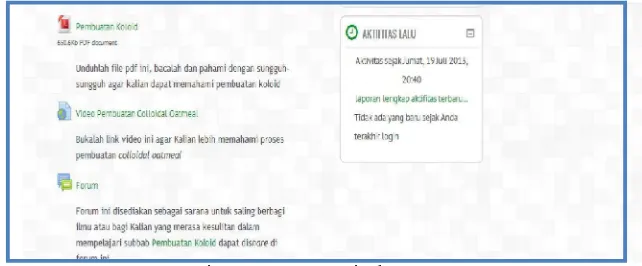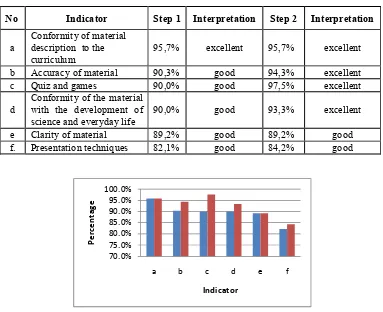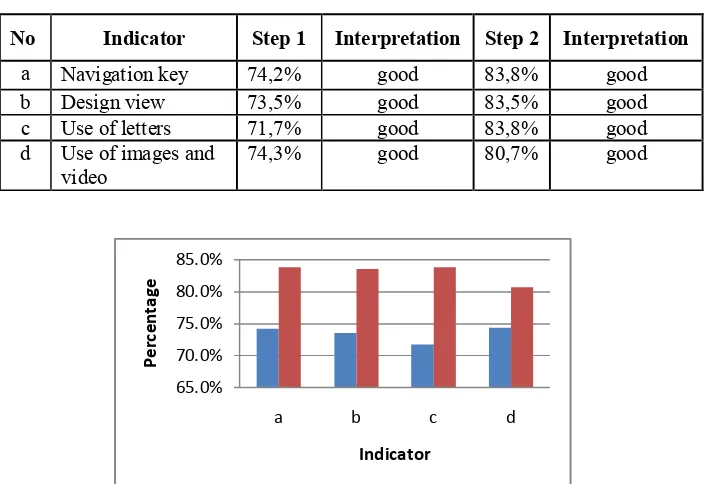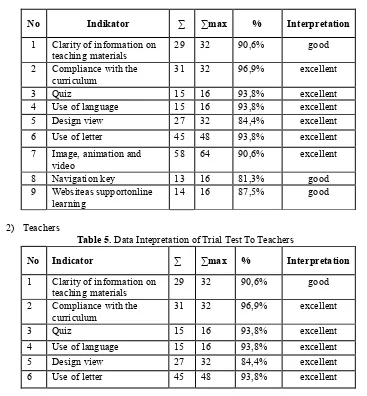CE-5
DEVELOPMENT OF ONLINE LEARNING USING MOODLE VERSION 2.5.3
(CASE STUDY AT SECONDARY SCHOOLS, JAKARTA)
Maria Paristiowati and Amanda Franciska
Chemistry Department, State University of Jakarta Email: [email protected]
Abstract
Paper reports the study of designing and developing Colloid’s online learning using Moodle version 2.5.3 at Secondary Schools, Jakarta. Design and developmentalresearchmethodology are conducted based on Richey and Klein model. Developmental process consists of several steps: (1) identyfying problems;(2) design and development research methodology;(3) participant selecting;(4) collecting data;(5) interpreting data; and (6) future development. Participants of the study are (1) researchers as designers, developers, and instructors; (2) teachers as instructors; (3) the experts as evaluators; and (4) students as learners. Data collection implemented several instruments, such as: (1) instrument of needs analysis; (2) feasibility test instruments, and (3) trial tests instruments. The results show the use of computers and internet is limited for searching references and learning materials. The online learning in Chemistry subjects in schools is not yet available. Teachers have not been able to create the online learning materials. On feasibility and trial test, the results show good performance on subject matter, clarity of information, and design.Therefore, the online learning can be implemented in chemistry learning.
Keyword: Design and Development Research, Online Learning, Moodle version 2.5.3, Colloid
A. Introduction
Internet is one of the application of information communication and technology (ICT) which is currently being developed rapidly. The report of MarkPlus Insight (2013) show that Internet users in Indonesia increase from 24.2 million people in 2012 to 31.7 million in 2013. Utilization of ICT for education in Indonesia based on the Regulation of the Minister of National Education Number 22 of 2006 and Regulation of the Minister of National Education Number 41 of 2007 which is said the curriculum should encourage students for using ICT to find information about the material (Kemdiknas, 2006), (Kemdiknas, 2007). So, internet can be used as a media to develop online learning.
The needs analysis have been done at 81 Senior High School Jakarta, 54 Senior High School Jakarta, and 2 Senior High School Jakarta. The results of the needs analysis show that 73 students grade XII and 7 chemistry teachers have used the internet and computers. It is the fact that 90.4% students and 100% teachers use Internet more than two times a week. 79.5% students and 66.7% teachers use computer more than twice a week. All students and teachers state that the schoolshaven’t got any chemistry online learning system.
matter. The result of Yehudit and Miri’s research (2003) said that learning by website can improve student learning outcomes and show high progress in understanding chemistry.
Online learning can be developed by one of the application of LMS (Learning Management System), Moodle, which is open source. Moodle has more advantages than other LMS. The features which are built based on the concept of pedagogy and technology (Tambovceva& Artis, 2013). Moodle version 2.5.3 is more stable and more compatible with the new features than old Moodle version.
Colloid contains a lot of applications in daily life, so it will be easier for learning if the material is presented in form of visualization and interactive. Website which is developed by Moodle version 2.5.3 can support visualization and interactive because it combines text, images, and videos which will be presented interestingly. Websites which have good quality visual can motivate students to learn chemistry (Margareta & Rahela, 2007).
Based on the above which describes about the use of internet and computers, the results of the needs analysis of students and teachers, the advantages of online learning, the advantages of Moodle version 2.5.3, and the characteristics of colloidal material, the research will develop an online learning based on Moodle version 2.5.3 for high school students grade XI at 81 Senior High School Jakarta. It is expected to increase students's understanding and interest to learn Colloid.
B. Research Methodology
The research methodology which is use is design and development research refers to Richey and Klein. The steps of research consist of: 1) Identyfying Problem, 2) Design and Development Research, 3) Selecting Participant, 4) Collecting Data, 5) Intepreting Data, and 6)Future Development (Richey &Klein, 2007). The aim of research is to design and develop Colloid’s online learning based on Moodle version 2.5.3.
C. Result and Discussion 1. Identyfying Problem
The aim of this step is to identify problems in chemistry learning system that has been doing in schools by distributing questionnaires to students and teachers. The result are all of students often usecomputer or laptop and 79.5% of students use them more than twice a week. All students are familiar with internet and 90.4% of them use it more than twice a week. Most of them access internet via computers, laptops, mobile phones, and smartphones. Internet is accessed at home, school, and other places that have internet facilities. They access internet for several purposes, including searching for information, doing homework, interacting in social media, watching video, and browsing learning materials.
Whole teachers ever use a computer or laptop and 66.7% of them use it more than twice a week. They know the internet and use it more than twice a week. Internet is used to find information, browse learning materials and chemistry reference, enter evaluation score, open email, and interact in social media. Websites that are used to search chemical reference are Royal Society of Chemistry, Chem-is-try.org, Wikipedia, and Cambridge Area Guide. Teachers use internet via smartphones, mobile phones, computers, and laptops.
The result identifies the usage of computers and the internet has been growing rapidly among students and teachers. Using computers and Internet is limited for searching reference and learning materials. Chemistry online learning system subject is not available. Teachers isn’t able to create an online learning.
2. Design and Development Research
content and background of learning online. The result show thatthe teachers and the students are desired attractive appearance with bright colors, using language which is understood easily, present material clearly, present applications, and video.
[image:3.612.145.468.220.399.2]Step of product arranging is made via online, the website address is http://elearningchemistry.com. It is started by analysis characteristics of material, plan design, content, and presentation technique of online learning, and select supporting software. Software which is used are Moodle 2.5.3 are supported Microsoft Word, Photoscape, Adobe Photoshop, and Corel Video Studio Pro X6. They are used to create quizzes, pictures and video.
Figure 1. Home Display
There are three parts which are presented in website, Home (front view), Login Page, and Course (learning activity). Course consist three sections, system and the properties of colloids, making colloid, and chemoenterpreneurship. The features in each section are introduction, subject matter (pdf), video, forum, chat, games, and quiz.
Figure 2. Course Display
3. Selecting Participant
[image:3.612.142.463.484.617.2]The step of collecting data is used several instruments, there are needs analysis instruments, feasibility instrument, and trial test instrument. Needs analysis to determine the condition of learning chemistry in school and online learning content and display are desired by students and teachers. Feasibility test instrument to evaluate the feasibility of online learning. Trial test instrument to determine the opinion of students and teachers of chemistry online learning has been developed. The trial test is conducted to 20 students of class XII at 81 Secondary School Jakarta and 4 Chemistry teacher.
The results of feasiblity test and trial test are processed by rating scale score of 1 to 4. In addition, inter-rater reliability test is to determine the inter-rater consistency in evaluating learning online using ICC (intraclass correlation coefficient) test (Djaali & Pudji, 2008). In the following below is a feasibility test and trial test data to students and teachers.
[image:4.612.113.496.304.616.2]a. Feasibility Test 1) Material Experts
Table 1. Intepretation Data of Feasibility Test by Material Experts
No Indicator Step 1 Interpretation Step 2 Interpretation
a Conformity of material description to the
curriculum 95,7% excellent 95,7% excellent
b Accuracy of material 90,3% good 94,3% excellent
c Quiz and games 90,0% good 97,5% excellent
d Conformity of the material with the development of
science and everyday life 90,0% good 93,3% excellent
e Clarity of material 89,2% good 89,2% good
f. Presentation techniques 82,1% good 84,2% good
Figure 3. Percentage Data of Feasibility Test by Material Experts 70.0%
75.0% 80.0% 85.0% 90.0% 95.0% 100.0%
a b c d e f
Pe
rc
en
ta
ge
2) Media Experts
Table 2. Intepretation Data of Feasibility Test by Media Experts
No Indicator Step 1 Interpretation Step 2 Interpretation
a Navigation key 74,2% good 83,8% good
b Design view 73,5% good 83,5% good
c Use of letters 71,7% good 83,8% good
d Use of images and
video 74,3% good 80,7% good
Figure 4. Data Percentage of Feasibility Test by Media Experts
[image:5.612.126.503.499.712.2]3) Language Experts
Table 3. Intepretation Data of Feasibility Test by Language Experts
No Indicator Step 1 Interpretation Step 2 Interpretation a Accordance to the
developmental level of students
85,8 good 87,1% good
b Communicative 89,2 good 89,2% good
c Use of letters and
punctuation correctly 83,2 good 87,7% good
d Use of the term
correctly 86,7 good 86,7% good
e Use of the sentences
correctly 81,3 good 85,0% good
f. The precision of writing a bibliography and source image
76,3 good 88,8% good
h Wholeness and unity of
ideas 87,5 good 87,5% good
65.0% 70.0% 75.0% 80.0% 85.0%
a b c d
Pe
rc
en
ta
ge
Figure 5. Percentage Data of Feasibility Test by Language Experts
[image:6.612.180.453.104.234.2]b. Trial Test 1) Students
Table 4. Intepretation Data of Trial Test for Students
No Indikator ∑ ∑max % Interpretation
1 Clarity of information on
teaching materials 29 32 90,6% good
2 Compliance with the
curriculum 31 32 96,9% excellent
3 Quiz 15 16 93,8% excellent
4 Use of language 15 16 93,8% excellent
5 Design view 27 32 84,4% excellent
6 Use of letter 45 48 93,8% excellent
7 Image, animation and
video 58 64 90,6% excellent
8 Navigation key 13 16 81,3% good
9 Websiteas supportonline
learning 14 16 87,5% good
2) Teachers
Table 5. Data Intepretation of Trial Test To Teachers
No Indicator ∑ ∑max % Interpretation
1 Clarity of information on
teaching materials 29 32 90,6% good
2 Compliance with the
curriculum 31 32 96,9% excellent
3 Quiz 15 16 93,8% excellent
4 Use of language 15 16 93,8% excellent
5 Design view 27 32 84,4% excellent
6 Use of letter 45 48 93,8% excellent
65.0% 70.0% 75.0% 80.0% 85.0% 90.0% 95.0%
a b c d e f g
Pe
rc
en
ta
ge
Indicator
[image:6.612.117.484.315.711.2]7 Image, animation and
video 58 64 90,6% excellent
8 Navigation key 13 16 81,3% good
9 Websiteas supportonline
learning 14 16 87,5% good
5. Intepreting Data
a. The results of feasibility test by material experts
Based on table 1 and figure 1, all indicators have good and excellent intepretation although there is a different range of values and an enhanchement from step 1 to2. Some improvement whichare recommended by material, there are: "colloidal particles of Fe(OH)3
positive charged in water.The surface will adsorb Fe3 +, which is supposed to adsorb H+ and
"water purification with water treatment plant should be replaced by natural materialsuch asmoringa seeds ".
Value of inter-rater reliability is 0.63, means good rater consistency. Based on the results of feasibility test and inter-rater reliability show materials are well developed, so it can be tested to students and teachers.
b. The results of feasibility test by material experts
Based on table 2 and figure 2, found that indicators navigation, display design, the usage of letters, images and video show good interpretation increase percentage from step 1 to2. Some corrections whichare recommended by media experts, the letters on section title should use upright font and videos that are presented should be equipped with explanation.
Value of inter-rater reliability is 0.64, it means good rater consistency. Based on the results of feasibility test and inter-rater reliability show media is well developed, then it can be tested to students and teachers.
c. The results of feasibility test by language experts
Based on table 3 and figure 3, it is found that communicative indicators, accuracy of glosssary, integrity and unity of ideas show same percentage of step 1 to 2, and have good interpretation. Other indicators, level of student progress, the accuracy of using letters, punctuations, glossary, sentences, bibliography, and source of images show increase percentage from step 1 to 2, and have good interpretation. Some improvement which isrecommended by language experts, there are some written spelling and punctuation which are not based on EYD (Ejaan Yang Disempurnakan), the usage of active and passive sentences which is not suitable should be repaired.
Value of inter-rater reliability is 0.65, it means good rater consistency. Based on the results of feasibility test and inter-rater reliability show good language. Then it can be tested to students and teachers.
d. The results of trial test to students and teachers
Trial test to students is conducted by researchers who are presented an online learning system and explained using website. Then the students scheduled to access website directly, and to do online learning activities such as reading material in PDF format, seeing the video, trying to express opinions through forum or chat, doing quiz and so on. After that, students filled out a questionnaire which was given by researchers to assess and give comments or suggestions regarding the online learning system.
order to they can be seen clearly and the rules of some standardization written questions on multiple choice quiz should be suitable.
Then the results of trial test to students (table 5) show good interpretation on all indicators. However, there are some improvementwhich is suggested by students, such as font size on homezoomed, the background color should be colored brighter, and speed of loading time is accelerated, in order students do not have to wait to open the website.
Based on the test results to students and teachers that have been outlined above so it can be concluded based online learning system Moodle 2.5.3 version that is good and fit to used for supplement the learning materials Colloids.
6. Future Development
After developing online learning based on Moodle version 2.5.3, it can test the effectiveness of online learning based on Moodle version 2.5.3 and development of online learning based on Moodle version 2.5.3 for other chemical materials.
D. Conclusion
Using internet and computers that is more increasing among teachers and students has not been supported by the presence of chemistry online learning in school. Therefore, researchers develop an online learning based on the needs analysis and characteristics of colloid which is using Moodle version 2.5.3.
Based on feasibilty test by media, materials, and language experts has shown good and excellent intepretation. The results of inter-rater reliability and the trial test for students and teachers haveshown good and excellent interpretation. It can be concluded online learning system based on Moodle version 2.5.3 is good and feasible to complete learning Colloid.
E. References
MarkPlus Insight. 2013. Pengguna Internet Indonesia 74 Juta di Tahun 2013.http://www.themarketeers.com/archives/Indonesia%20Internet%20Users.html#.UtKU UNKSxic. (Accessed on 12th January 2013).
Menteri Pendidikan Nasional. Peraturan Menteri Pendidikan Nasional Republik Indonesia No 22 Tahun 2006. Jakarta : Departemen Pendidikan Nasional.
__________. Peraturan Menteri Pendidikan Nasional Republik Indonesia No 41 Tahun 2007. Jakarta : Departemen Pendidikan Nasional.
Yehudit & Miri. 2003. A Web-Based Chemistry Course as a Means To Foster Freshmen Learning. Journal of Chemical Education. 80(9). 1084-1092
Tambovceva, T dan Artis, I. 2013. Development of Moodle : Case of Riga Technical University. Proceedings of 2013 International Conference on Education and Educatinal Technologies. Margareta dan Rahela. 2007. E-Learning in Chemistry : To Use It or Not to Use it.10th
Intermational Multi-Conference. Slovenija : University of Ljubljana.
Richey, R. dan James, K. 2007. Design and Development Research. New Jersey: Lawrence Erlbaum Associates Publishers.
Djaali dan Pudji. 2008. Pengukuran Dalam Bidang Pendidikan. Jakarta : Grasindo
Varjola, Irma. 2000. Use of The Internet In The Teaching of Chemistry in Finnish Schools: A Case Study. Chemistry Education : Research and Practice in Europe. 1(1). 121-128. Shiang Kwei dan Thomas. 2007. The Effects of a Web-Based Learning Environment on Student



